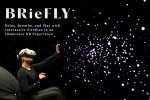We’re excited to share that three projects from the iSpace Lab are being presented at CHI 2025, the premier international conference on Human Factors in Computing Systems, held this year in Yokohama, Japan!
Our contributions this year highlight new research on embodiment in VR, fostering emotional well-being through mindful interaction, and developing virtual reality exposure therapies grounded in cross-cultural perspectives.
Here’s an overview of the projects we’re showcasing:
Being in Virtual Worlds: How Interaction Environment and Touch Shape Embodiment in Immersive Experiences
Authors: John Desnoyers-Stewart, Alissa N. Antle, Bernhard E. Riecke
Type: Full Research Paper (CHI Proceedings)
DOI: https://doi.org/10.1145/3706598.3713586
Project page: Learn more here
 This research investigates how different interaction environments and the incorporation of physical touch influence users’ sense of embodiment within virtual environments. By examining how users experience their virtual bodies and environments through interaction and haptics, the study offers critical insights for designing future VR experiences that feel more natural, immersive, and meaningful.
This research investigates how different interaction environments and the incorporation of physical touch influence users’ sense of embodiment within virtual environments. By examining how users experience their virtual bodies and environments through interaction and haptics, the study offers critical insights for designing future VR experiences that feel more natural, immersive, and meaningful.
We explore how elements such as object affordances, textures, and the surrounding environment shape embodiment — and ultimately, how these insights can improve virtual reality applications in entertainment, education, and therapy.
BRieFLY: Mindful Breathing and Playful Interaction to Foster Self-Connection in Mixed Reality
Authors: Deniz G. Ural, Rayne Inkster, John Desnoyers-Stewart, Faranak Farzan, Bernhard E. Riecke
Type: Work-in-Progress (Extended Abstracts)
DOI: https://doi.org/10.1145/3706599.3720237
Project page: Learn more here
 BRieFLY explores how combining mindful breathing techniques with playful interaction in VR can foster self-awareness, emotional regulation, and self-connection. With growing concerns around mental health, VR presents a powerful medium to deliver interventions in engaging and accessible ways.
BRieFLY explores how combining mindful breathing techniques with playful interaction in VR can foster self-awareness, emotional regulation, and self-connection. With growing concerns around mental health, VR presents a powerful medium to deliver interventions in engaging and accessible ways.
Our mixed-reality prototype invites users into an interactive environment where their breathing patterns shape playful visual and auditory feedback, making mindfulness more intuitive and enjoyable.
HemisFear: A Virtual Reality Exposure Therapy Prototype Driven by Cross-Cultural Understanding of Dog Phobia
Authors: Jacob Sauer, Bernhard E. Riecke
Type: Work-in-Progress (Extended Abstracts)
DOI: https://doi.org/10.1145/3706599.3719970
Project page: Learn more here
 Cynophobia — the fear of dogs — affects many individuals worldwide. While live exposure therapy is a proven treatment, it can be costly, unpredictable, and culturally complex. HemisFear introduces a VR-based exposure therapy prototype designed to be both customizable and culturally sensitive.
Cynophobia — the fear of dogs — affects many individuals worldwide. While live exposure therapy is a proven treatment, it can be costly, unpredictable, and culturally complex. HemisFear introduces a VR-based exposure therapy prototype designed to be both customizable and culturally sensitive.
Drawing on cross-cultural insights into dog perceptions and fears, this prototype offers a safe, controlled environment for exposure therapy, potentially making treatment more accessible and tailored to diverse populations.
If you’re attending CHI 2025, we’d love for you to come by and chat with us about these projects!
For more information about our ongoing research into VR, well-being, embodiment, and beyond, visit our iSpace Lab Projects page.